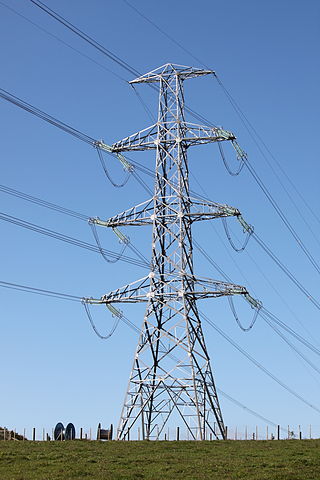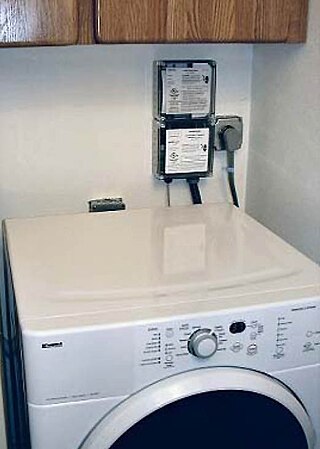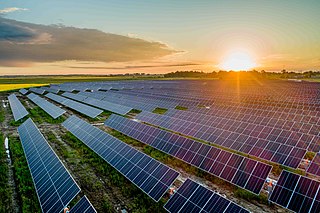
The electric power industry covers the generation, transmission, distribution and sale of electric power to the general public and industry. The commercial distribution of electric power started in 1882 when electricity was produced for electric lighting. In the 1880s and 1890s, growing economic and safety concerns lead to the regulation of the industry. What was once an expensive novelty limited to the most densely populated areas, reliable and economical electric power has become an essential aspect for normal operation of all elements of developed economies.

An electricity meter, electric meter, electrical meter, energy meter, or kilowatt-hour meter is a device that measures the amount of electric energy consumed by a residence, a business, or an electrically powered device over a time interval.

The State Grid Corporation of China (SGCC), commonly known as the State Grid, is a Chinese state-owned electric utility corporation. It is the largest utility company in the world. As of March 2024, State Grid is the world's third largest company overall by revenue, behind Walmart and Amazon. In 2023 it was reported as having 1.3 million employees, 1.1 billion customers and revenue equivalent to US$546 billion. It is overseen by the State-owned Assets Supervision and Administration Commission of the State Council.

Demand response is a change in the power consumption of an electric utility customer to better match the demand for power with the supply. Until the 21st century decrease in the cost of pumped storage and batteries, electric energy could not be easily stored, so utilities have traditionally matched demand and supply by throttling the production rate of their power plants, taking generating units on or off line, or importing power from other utilities. There are limits to what can be achieved on the supply side, because some generating units can take a long time to come up to full power, some units may be very expensive to operate, and demand can at times be greater than the capacity of all the available power plants put together. Demand response, a type of energy demand management, seeks to adjust in real-time the demand for power instead of adjusting the supply.

A smart meter is an electronic device that records information—such as consumption of electric energy, voltage levels, current, and power factor—and communicates the information to the consumer and electricity suppliers. Such an advanced metering infrastructure (AMI) differs from automatic meter reading (AMR) in that it enables two-way communication between the meter and the supplier.

The energy policy of the United States is determined by federal, state, and local entities. It addresses issues of energy production, distribution, consumption, and modes of use, such as building codes, mileage standards, and commuting policies. Energy policy may be addressed via legislation, regulation, court decisions, public participation, and other techniques.

Iran possesses significant energy reserves, holding the position of the world's third-largest in proved oil reserves and the second-largest in natural gas reserves as of 2021. At the conclusion of the same year, Iran's share comprised 24% of the oil reserves in the Middle East and 12% of the worldwide total.

The smart grid is an enhancement of the 20th century electrical grid, using two-way communications and distributed so-called intelligent devices. Two-way flows of electricity and information could improve the delivery network. Research is mainly focused on three systems of a smart grid – the infrastructure system, the management system, and the protection system. Electronic power conditioning and control of the production and distribution of electricity are important aspects of the smart grid.

Ghana generates electric power from hydropower, fossil-fuel, and renewable energy sources such as wind and solar energy. Electricity generation is one of the key factors in order to achieve the development of the Ghanaian national economy, with aggressive and rapid industrialization; Ghana's national electric energy consumption was 265 kilowatt hours per each one in 2009.
Brazil has the largest electricity sector in Latin America. Its capacity at the end of 2021 was 181,532 MW. The installed capacity grew from 11,000 MW in 1970 with an average yearly growth of 5.8% per year. Brazil has the largest capacity for water storage in the world, being dependent on hydroelectricity generation capacity, which meets over 60% of its electricity demand. The national grid runs at 60 Hz and is powered 83% from renewable sources. This dependence on hydropower makes Brazil vulnerable to power supply shortages in drought years, as was demonstrated by the 2001–2002 energy crisis.

China is the world's largest electricity producer, having overtaken the United States in 2011 after rapid growth since the early 1990s. In 2021, China produced 8.5 petawatt-hour (PWh) of electricity, approximately 30% of the world's electricity production.

An electrical grid is an interconnected network for electricity delivery from producers to consumers. Electrical grids consist of power stations, electrical substations to step voltage up or down, electric power transmission to carry power over long distances, and finally electric power distribution to customers. In that last step, voltage is stepped down again to the required service voltage. Power stations are typically built close to energy sources and far from densely populated areas. Electrical grids vary in size and can cover whole countries or continents. From small to large there are microgrids, wide area synchronous grids, and super grids. The combined transmission and distribution network is part of electricity delivery, known as the power grid.
The term smart grid is most commonly defined as an electric grid that has been digitized to enable two way communication between producers and consumers. The objective of the smart grid is to update electricity infrastructure to include more advanced communication, control, and sensory technology with the hope of increasing communication between consumers and energy producers. The potential benefits from a smart grid include increased reliability, more efficient electricity use, better economics, and improved sustainability.

Denmark's western electrical grid is part of the Synchronous grid of Continental Europe whereas the eastern part is connected to the Synchronous grid of Northern Europe via Sweden.

Lithuania is a net energy importer. In 2019 Lithuania used around 11.4 TWh of electricity after producing just 3.6 TWh.

China is the world's largest consumer of electricity, and its demand is expected to double by the next decade, and triple by 2035. In 2010, 70 percent of the country's electricity generation came from coal-fired power plants, but the Chinese government is investing heavily in renewable energy technologies. As of 2013, 21 percent of China's electricity generation comes from renewable sources. This represents only 9 percent of overall primary energy consumption in the country. China's latest goal is to increase renewable energy to 9.5 percent of overall primary energy use by 2015. To implement China's new clean energy capacity into the national power grid, and to improve the reliability of the country's existing infrastructure, requires significant upgrades and ultimately, a smart grid.
A Distribution Transformer Monitor (DTM) is a specialized hardware device that collects and measures information relative to electricity passing into and through a distribution transformer. The DTM is typically retrofitted onto pole top and pad mount transformers. A pole top or pad mount transformer commonly powers anywhere from 5-8 homes in the US and is the last voltage transition in stepping down voltage before it gets to the home or business. The conventional placement of Distributed Temperature Monitoring (DTM) devices is typically observed at the terminals of transformers. However, there are instances where these devices are directly affixed to the secondary power lines.

Tata Power Delhi Distribution Limited (TPDDL) is an Indian electric utility serving the northern and western parts of Delhi. It is a joint venture between the Government of NCT of Delhi and Tata Power Company Limited, which holds a 51% majority stake in the venture.

Turkey uses more electricity per person than the global average, but less than the European average, with demand peaking in summer due to air conditioning. Most electricity is generated from coal, gas and hydropower, with hydroelectricity from the east transmitted to big cities in the west. Electricity prices are state-controlled, but wholesale prices are heavily influenced by the cost of imported gas.
Electricity theft, also known as hooking, or kunda system in local language, is a chronic issue throughout Pakistan. Street protests in Pakistan for power outages and poor grid performance are common. Despite public pressure, the government of Pakistan has failed to resolve the issue, and has been criticised for its responses to victims of electricity supply shortages.

















